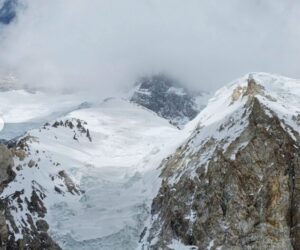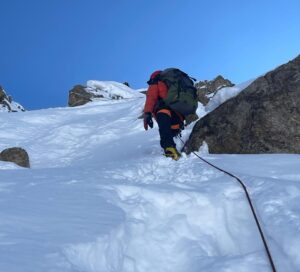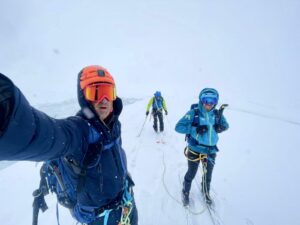Last year on July 19, Rafal Fronia of Poland sped alone up Broad Peak. It was a dream ascent on his dream mountain. Yet on the summit ridge at around 8,000m, Fronia saw something that shattered his heart: the body of Tomasz Kowalski. Kowalski’s body had remained there frozen since he died during the first winter climb of Broad Peak in 2013.
Fronia says that he was not thinking of the deceased climber when he climbed Broad Peak. “But for some reason, we finally met: Tomek (Tomasz Kowalski) was lying on a rocky spur, where Jacek Jawien and Jacek Berbeka had left him.”

The Rocky Summit of Broad Peak. Photo: Rafal Fronia
Background: The 2013 winter tragedy
The National Polish Mountaineering Association’s 2013 winter Broad Peak expedition was an epic climb, despite the tragic descent and later controversy in Poland. The leader, Maciej Berbeka, had a history with the mountain. On a previous attempt 25 years earlier, he had mistakenly stopped at the foresummit.

Maciej Berbeka and Tomasz Kowalski. Photo: Polski Himalaizm Sportowy
Berbeka, Kowalski, Adam Bielecki, and Adam Małek took part in the final summit push. All four summited on March 5 in harsh conditions. But some climbed faster than others and they became separated on the final, long summit ridge.
Berbeka and Tomasz Kowalski never made it back to Camp 4. While Berbeka’s body was never found, Kowalski passed near the so-called Rocky Summit. When the survivors returned home, the mountaineering public sharply questioned their tactics and why the climbers had not turned around or waited for each other.
Ten years on the ridge
Fronia knows about winter ascents and rescues: He attempted Winter K2 in 2018 and is also a member of Poland’s National Climbing team. He felt compelled to do something.
“Tomek had lain there for 10 years, 4 months and 13 days; 3,787 days and 3,787 nights; 10 of the world’s harshest winters,” Fronia said.
The thought made his own descent sad rather than joyful, as it should have been after his success. He resolved to return and give the Polish winter pioneer a proper burial.

Rafal Fronia and Piotr Tomala in the Tatras last winter. Photo: Rafal Fronia/Facebook
It was not easy to find support at first. Even Kowalski’s family found it hard to believe that he really intended to transport a body down from 8,000m after 10 years in the ice. But he and long-time expedition partner Piotr Tomala started raising funds. Poland’s Olympic Committee became involved.
The climbing community also responded. Volunteers offered to join Fronia on Broad Peak. In the end, five climbers accompanied him on this unusual mission: Jarek Gawrysiak, Grzegorz Borkowski, Marek Chmielarski, Krzysztof Stasiak, and Marcin Kaczkan.
The recovery
The team spent months researching, planning, and practicing the best possible way to perform such an operation. In June, they quietly set off.

The recovery team and relatives during a farewell ceremony held by Poland’s Olympic Committee. Photo: Wspinanie.pl
The task was hard. Fronia explained that it was not a normal summit push with light equipment. It involved many hours of work, hundreds of meters of rope, a stretcher, some kind of reinforced bag for the body, belaying equipment, and oxygen because they couldn’t take any risks. They did not bother to summit Broad Peak. They merely climbed to Kowalski’s remains and began to work.

Kowalski during a press conference before the 2013 expedition to winter Broad Peak. Photo: https://wspinanie.pl/
The final resting place
“The team headed up to the body from Camp 3 and spent about 14 hours working before returning to Camp 3,” Piotr Turkot, publisher of Wspinanie, told ExplorersWeb. “The body was on rocky ground near the route, within sight of passing climbers. That’s one of the main reasons why Fronia wanted to move him.”
A Polish team had moved the body of Kowalski away from the ropes in the summer of 2013, but as years went by, it had become visible again.
“The family preferred that Tomek remained on the mountain or in the vicinity of Broad Peak,” said Turkot. “So the team considered several options to give the body a proper burial — the Gilkey Memorial below Base Camp, a crevassed area around 7,000m, building a grave with stones in the rocky area near Camp 2. But then they found the cave, an ice-rock tunnel sheltered below the ridge, on the Chinese side of the mountain. It was just the right place, so they deposited the body there and covered it.”
“After a month of acclimatization, on July 19, almost to the minute a year after I met Tomek, his time on the Broad Peak ridge ended after 3,787 days,” Fronia wrote. “We buried him in a beautiful ice cave.”
He also said that, once back on the moraine, they all cried.
Kurtyka: The greatest feat
After the mission, the legendary Wojtek Kurtyka shared some words about it.
“It’s the kind of achievement I’d trade any of my sporting achievements for,” he told Wspinanie.pl. “I am convinced that this action is one of the most beautiful events in the history of Polish mountaineering. Perhaps the greatest. I mean, I’m talking about beauty here, not some f****g record or success that divides more than unites.”






